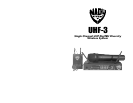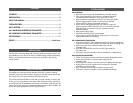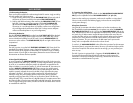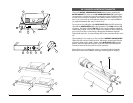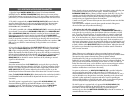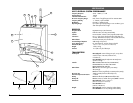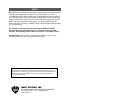
9
(Note: Scratchy noises can sometimes occur when some electric guitars with dirty pots
or connections are used with any wireless system. Therefore, the supplied
INSTRUMENT CORD (34) has a factory installed capacitor inside the 1/4" plug. This
capacitor provides first order filtering of the RF signal from the cord into the guitar
and eliminates virtually all scratchy noises. Should your equipment still give you
scratchy noises, we suggest these steps to eliminate them:
1) Make sure all guitar volume and tone pots are clean and all contacts are solid–this
is very important.
2) A 47pf capacitor soldered across the hot to ground terminals of the guitar’s
volume and tone pots will provide extra filtering.)
6. Microphone Use (with either a lavalier or headworn microphone)
Secure the connection from the LAVALIER (36) or HEADWORN MIC CORD (35) by
turning the slip ring on the plug into the transmitter clockwise to thread it on to the
jack. To unplug, reverse the process. To use the lavalier mic, attach it at chest level.
Do not place it too close to the mouth–a distance of about six inches usually works
best. To use the headworn mic, place it on the head and adjust the boom so that the
mic is about one inch to the side of the front of the mouth. As the microphone cord
also serves as the antenna, be sure to extend it fully. Rolling up or shortening the cord
may reduce the effective operating range–keep it as straight as possible. When ready
to speak, slide the audio MUTE SWITCH (27) to the ON position. Adjust the volume of
the receiver as per the Audio Output Microphone Connection section of the above
UHF-3 receiver instruction
[Note: Observe care in selecting P.A. volume, transmitter location and speaker
placement so that acoustic feedback (howling and screeching) will be avoided. Please
also note the pickup pattern characteristics of the microphone selected.
Omnidirectional mics pick up sound equally from all directions, and are prone to
feedback if not used carefully. Unidirectional mics are more resistant to feedback, but
pick up sound sources best that are directly in front of the mic. Also, mics that are
farther from the sound source, such as lavaliers, require more acoustic gain and thus
are also more prone to feedback than close-source mics such as handheld or
headworn models that are used close to the mouth].
For optimum performance, an INPUT LEVEL CONTROL (25) is provided. Adjust the
gain by turning the control with a small screw driver. For lavalier mic use, it is
recommended that the level be set at about 2/3 maximum. For headworn mic use, it
may be advisable to turn the gain down somewhat, depending on the volume levels
expected. In either application, experiment and set for maximum possible gain
without audible distortion on the high level peaks. (Note: Turning down the gain too
much can compromise the signal-to-noise and is not recommended.)
The UHF-3 receiver is equipped with a 5 segment LED AF LEVEL DISPLAY (14).
Occasional flickering of the top AF Peak LED indicator on loud inputs to the
transmitter is normal. If this LED lights continuously, but if the LED stays lit
continuously, turn down the INPUT LEVEL CONTROL (25) on the UB-3 transmitter, or
noticeable distortion may result.
8
1. Open the hinged BATTERY DOOR (23) and insert 2 fresh AAA ALKALINE
BATTERIES into the BATTERY COMPARTMENT (24), observing the correct polarity.
Fresh alkaline batteries can last up to 5 hours in use, but in order to ensure optimum
performance, it is recommended that the batteries be replaced after 3-4 hours of use.
2. The UB-3 is equipped with an INPUT SELECTOR SWITCH (32) located under the
cover for selecting the type of audio input you will be supplying to the transmitter.
Select from the choice of three positions: INSTRUMENT (for guitar, bass, etc.)/
HEADWORN MIC/ LAVALIER MIC.
3. The UB-3 is provided with a 3.5 mm LOCKING JACK (26) for connecting the audio
input selected. Connect either the INSTRUMENT CORD (34) or the HEADWORN MIC
(35) or LAVALIER MIC CORD (36) as desired, according to the input selected. (Note:
Use only the input audio source as per the input selected with the AUDIO INPUT
SELECTOR SWITCH or the audio will not be optimal–a muddy or distorted sound may
result.) To secure the connection, turn the slip ring on the plug clock wise to thread
it on the jack. To unplug, reverse the process. Slip the transmitter into a pocket or CLIP
(33) it on to your clothes or instrument strap (if using the UB-3 as an instrument
transmitter).
4. Turn on the UB-3 by sliding the audio MUTE SWITCH (27) to the ON position first.
Then slide the POWER SWITCH (29) to the ON position. The battery indicator LED
(28) will give a single quick flash, indicating usable battery strength. In the case of
dead or low batteries, the LED will either not go on at all or will stay on continuously,
indicating that the batteries should be replaced with fresh ones. To preserve battery
life, turn the transmitter off when not in use. The A AND/OR B DIVERSITY LED
INDICATORS (13) on the UHF-3 receiver should now be lit, indicating a received
signal from the transmitter.
5. Instrument Use
Secure the connection from the GT CABLE (34) by turning the slip ring on the plug
into the transmitter clockwise to thread it on the jack. To unplug, reverse the process.
Plug the 1/4” phone plug into the instrument. When ready to play, slide the audio
MUTE SWITCH (27) to OFF position Adjust the volume of the receiver as per the
Audio Output Instrument Connection section of the above UHF-3 receiver instruction.
(Note: The INPUT LEVEL CONTROL (25) is deactivated and not used when the UB-3 is
in INSTRUMENT mode. Levels should be adjusted with the volume control of your
instrument.)
The UHF-3 receiver is equipped with a 5 segment LED AF LEVEL DISPLAY (14).
Occasional flickering of the top AF Peak LED indicator on loud inputs to the
transmitter is normal. If this LED lights continuously, turn down the INPUT LEVEL
CONTROL (25) on the UB-3 transmitter, or noticeable distortion may result.
UB-3 BODYPACK MICROPHONE TRANSMITTER



